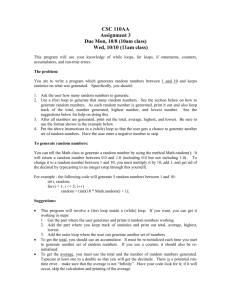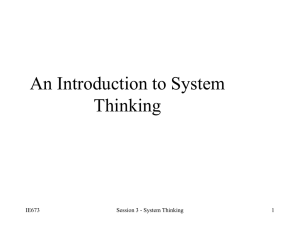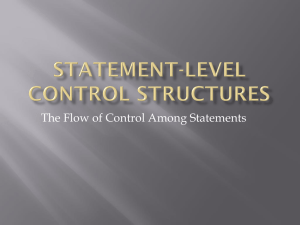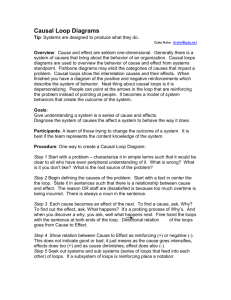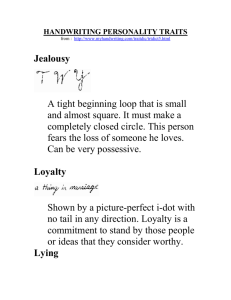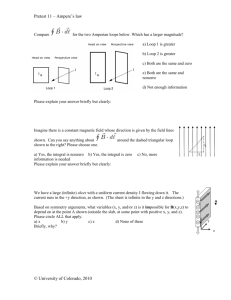39902023 - Telecommunications Industry Association
advertisement
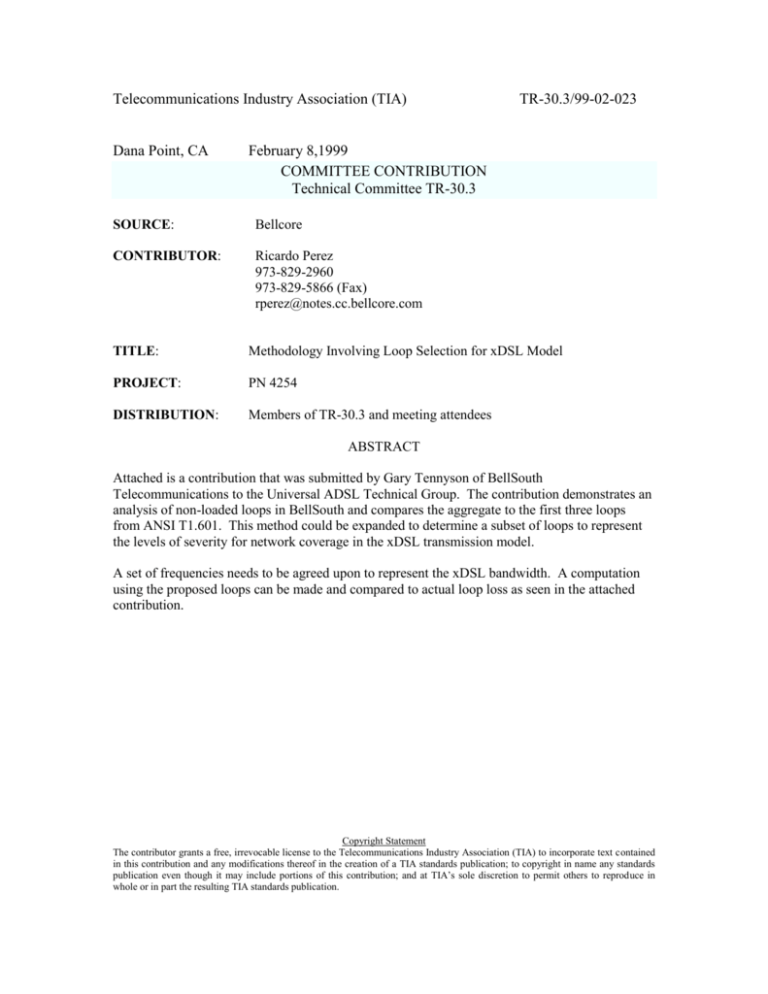
Telecommunications Industry Association (TIA) Dana Point, CA TR-30.3/99-02-023 February 8,1999 COMMITTEE CONTRIBUTION Technical Committee TR-30.3 SOURCE: Bellcore CONTRIBUTOR: Ricardo Perez 973-829-2960 973-829-5866 (Fax) rperez@notes.cc.bellcore.com TITLE: Methodology Involving Loop Selection for xDSL Model PROJECT: PN 4254 DISTRIBUTION: Members of TR-30.3 and meeting attendees ABSTRACT Attached is a contribution that was submitted by Gary Tennyson of BellSouth Telecommunications to the Universal ADSL Technical Group. The contribution demonstrates an analysis of non-loaded loops in BellSouth and compares the aggregate to the first three loops from ANSI T1.601. This method could be expanded to determine a subset of loops to represent the levels of severity for network coverage in the xDSL transmission model. A set of frequencies needs to be agreed upon to represent the xDSL bandwidth. A computation using the proposed loops can be made and compared to actual loop loss as seen in the attached contribution. Copyright Statement The contributor grants a free, irrevocable license to the Telecommunications Industry Association (TIA) to incorporate text contained in this contribution and any modifications thereof in the creation of a TIA standards publication; to copyright in name any standards publication even though it may include portions of this contribution; and at TIA’s sole discretion to permit others to reproduce in whole or in part the resulting TIA standards publication. Universal ADSL Technical Group Contribution Document # TG/98-057 Atlanta, GA, March 10 & 11, 1998 SOURCE: Gary Tennyson BellSouth Telecommunications Telephone (205) 985 6087 Fax (205) 733 5603 Email gary.j.tennyson@bridge.bst.bls.com TITLE: Proposed Loop Reach / Performance Requirements ABSTRACT: This contribution justifies the need for coverage of at least 99% of the non-loaded loop population. Analysis is also presented that indicates that Loops 1, 2 & 3 from T1.601 are good approximations to the 99% point. Minimum downstream data rates at the 99%, 90% and 60% points are also proposed. Introduction This contribution is provided in response to a debate at the last SIG meeting on the subject of loop coverage. The question is essentially the following: Over what loops, and at what data rates, should ADSL-lite operate? The Service Model It should be pointed out that the service model for ADSL-lite (and for conventional ADSL, for that matter) is not that for voiceband-data modems. Voiceband-data modems are used in end-to-end scenarios where the (telephone) service provider plays no role in the data service (other than providing an analog channel). In the ADSL-lite model, the (telephone) service provider provides both the analog channel (the loop) and one of the ADSL modems. In this scenario, the provider must provide an acceptable quality of service. There is one other pertinent difference between voiceband-data and the proposed ADSL-lite service. This has to do with the ubiquity of service. Voiceband-data modems work at some rate on practically any loop. ADSL-lite, on the other hand, will never work on loaded loops. In some areas, this may be a significant percentage of loops. It is not even clear at this point that ADSL-lite will operate on longer, non-loaded loops. For this reason, it is desirable that potential customers not purchase the ADSL-lite CPE until the service provider indicates that ADSL-lite is available at the customer’s location. This places demands on the service provider’s internal processes. In a relatively short time frame, a determination as to whether ADSL-lite will work (at an acceptable quality of service) must be made. This determination is often denoted ‘loop qualification.’ Loop Qualification Loop qualification obviously requires some sort of examination of the loop. End-to-end testing of the loop would be very accurate but would require a premises visit. The resultant delays are unacceptable to the end-user. The alternative is reliance on loop records. Records may exist in many forms. Looking again at the time frame in which loop qualification must be done, mechanized records are needed. In most cases, the only mechanized loop records system available for this purpose is the system used to ‘assign’ a line to a particular cable pair and serving terminal. The capabilities of this mechanized assignment system vary from company to company. In many companies, the only data available in the system to ‘qualify’ a loop is an indication of whether a particular cable pair is loaded (or not.) Coverage To summarize the above, the only loop information, readily available at the time of service negotiation, may be whether it is loaded or not. Given this, we suggest that ADSL-lite be capable of providing some minimum grade of service (we suggest a downstream data rate of 128 kb/s excluding ATM overhead) on practically all non-loaded loops. When considering the actual percentage of loops to be covered, we need to recognize that most service providers are in the business of providing service with high availability. In this context, they are not equipped or inclined to deal with any significant number of customers that once they have committed to serve them cannot be served. For this reason, we suggest that an ADSL-lite standard require operation, at the above data rate, on 99% of the non-loaded loops. Rate Adaptation We are not suggesting that the above data rate is acceptable for all customers. In fact, our best estimate is that at least 256 kb/s downstream (excluding ATM overhead) is required on 90% of the customer’s loops. Finally, our estimate is that at least 1 Mb/s, again excluding ATM overhead, is needed on 60% of the non-loaded loops. These requirements are repeated in the following table. Assuming that ATM overhead adds about 15%, a third column is shown that includes the ATM overhead. Percentile Required Downstream Line Rate Required Downstream Line Rate (excluding ATM overhead) (including ATM overhead) (kb/s) (kb/s) 60 1000 1150 90 256 294 99 128 147 We are not making any proposals at this time regarding upstream performance. Translation of Loop Coverage Goals into Specific Test Loops These goals regarding loop coverage and data rates need to be translated into specific performance requirements. We offer the following analysis that defines a set of loops as a good approximation of the 99% point. Additional analysis is needed to approximate the 60% and 90% points. A Cumulative Distribution Function (CDF) of the loss of a large sample of non-loaded loops in BellSouth is shown below. The specific frequencies were selected to give some insight into the potential performance in both the upstream and downstream directions. C D F o f L o o p L o s s 1 8 0 0 + n o n l o a d e d l o o p s i n B e l l S o u t h 1 0 0 9 0 8 0 7 0 6 0 1 5 0 k H z Percntagoflps<x 5 0 4 0 3 0 5 0 k H z 2 5 0 k H z 2 0 1 0 0 0 5 1 0 1 5 2 0 2 5 3 0 3 5 4 0 4 5 5 0 5 5 6 0 6 5 7 0 7 5 L o s s b e t w e e n 1 0 0 O h m t e r m i n a t i o n s ( d B ) The next graph is an expanded CDF, showing the same data between the 90 and 100 percentiles. The loss (at these same frequencies) of the three test loops from T1.601 (ISDN BRA), Loops 1, 2 and 3 is also shown. It can be seen that these three test loops provide a fair representation of something near the 99% point (at least in terms of loop loss at these frequencies). E x p a n d e d C D F o f L o o p L o s s 1 8 0 0 + n o n l o a d e d l o o p s i n B e l l S o u t h 1 0 0 9 9 9 8 9 7 9 6 9 5 Percntagoflps<x 5 0 k H z 9 4 9 3 9 2 9 1 1 5 0 k H z 2 5 0 k H z T 1 . 6 0 1 , L o o p 1 T 1 . 6 0 1 , L o o p 2 T 1 . 6 0 1 , L o o p 3 9 0 4 0 4 5 5 0 5 5 6 0 6 5 7 0 7 5 8 0 L o s s b e t w e e n 1 0 0 O h m t e r m i n a t i o n s ( d B ) Noise and Margin on the 99% Loops The noise environment in which system should be required to operate on a 99% loop is not clear. Coupling the 99% loop, the 99% crosstalk noise coupling model, and a worst-case set of interferers yields a scenario that will not likely be encountered in the field. Regarding interferers, our estimate is that the most likely are the following: FEXT from other ADSL systems (from both the CO and remote systems) NEXT from residential Basic Rate Access ISDN systems Clearly, something less than 6 dB of margin is appropriate on these very long loops. Proposed Requirements We propose the following requirements: The system shall be rate-adaptive. It shall provide at least 150 kb/s of payload (including ATM overhead) in the downstream direction on T1.601, Loops 1, 2 & 3. This requirement shall be met in the presence of both, but not simultaneous (a) FEXT from 49 ADSL disturbers, and (b) NEXT from 49 DSL disturbers. In order to demonstrate compliance, the system shall operate at a BER of 10-7 or better, with at least 4 dB of margin.
